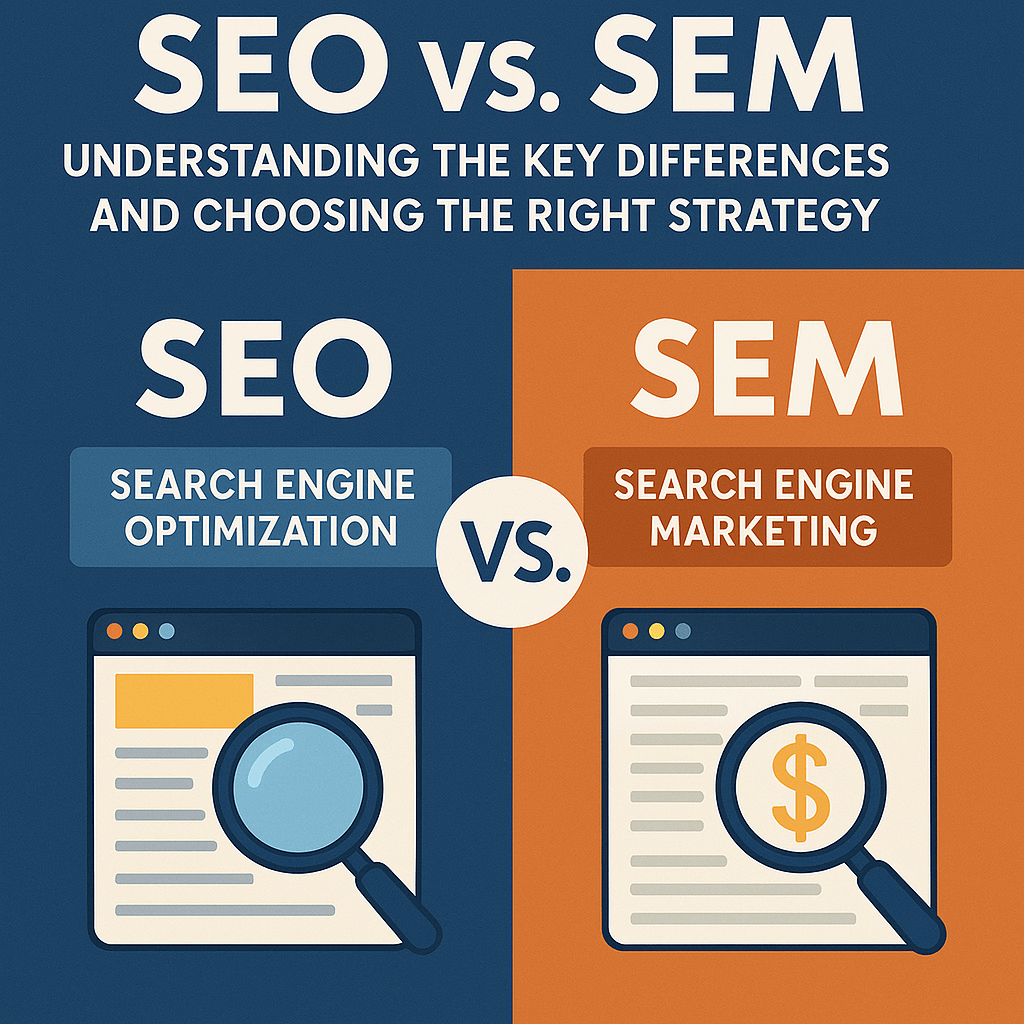SEO (Search Engine Optimization) and SEM (Search Engine Marketing) are both essential strategies for increasing visibility on search engines, but they differ in their approach, cost, and long-term impact. Understanding the distinction between these two can help you choose the right strategy for your digital marketing goals.
What is SEO?
SEO is the practice of optimizing your website to rank higher in organic (non-paid) search engine results. The goal is to attract users by providing relevant, high-quality content that search engines can easily index. SEO involves several key components:
-
On-Page SEO: This focuses on optimizing individual pages on your website to rank for targeted keywords. This includes optimizing title tags, meta descriptions, headers, content, and images to align with user search intent.
-
Off-Page SEO: This refers to actions taken outside your website to improve its authority and trustworthiness. The most common technique is link building, where other reputable websites link to your content. Backlinks are a major ranking factor for search engines like Google.
-
Technical SEO: This ensures that your website is easily crawlable and indexable by search engines. Key factors include improving site speed, ensuring mobile-friendliness, creating a clean URL structure, and fixing any technical issues like broken links.
The main benefit of SEO is that it provides long-term visibility and sustainable traffic without ongoing payment for clicks. However, SEO takes time to produce results. It may take months to see significant traffic, but once you achieve top rankings, the traffic is consistent and relatively low-cost.
What is SEM?
SEM is a broader term that encompasses both SEO and paid search advertising (such as PPC, or Pay-Per-Click ads). While SEO is focused on organic results, SEM includes the use of paid advertisements to drive immediate traffic from search engines.
The most common form of SEM is PPC advertising, where businesses pay for ads to appear in search results for specific keywords. For example, Google Ads allows businesses to bid on keywords and display ads at the top or bottom of the search engine results page (SERP).
The primary advantage of SEM is its immediacy. You can start driving traffic to your site as soon as your ads go live. However, the downside is that SEM can be expensive, especially for competitive keywords, and the traffic stops once you stop paying for ads.
Key Differences Between SEO vs. SEM
-
Cost:
-
SEO is mostly free after the initial investment of time and resources to optimize your site. However, it requires ongoing effort to maintain rankings.
-
SEM involves paying for ads, which means you pay for each click or impression. Costs can vary widely depending on the competition for the keyword.
-
-
Timeframe:
-
SEO is a long-term strategy that can take several months to show results, but it provides lasting benefits once you achieve high rankings.
-
SEM provides immediate results. As soon as you set up and launch your ads, they will begin to drive traffic to your site.
-
-
Sustainability:
-
SEO delivers sustainable traffic over time, as long as your content remains relevant and your website continues to be optimized.
-
SEM traffic stops as soon as you stop running ads, making it less sustainable in the long term.
-
When to Use SEO vs. SEM
-
SEO is ideal for informational keywords where users are looking for answers or knowledge (e.g., “how to start a blog”). SEO builds trust and authority over time, making it a good strategy for content marketing.
-
SEM is great for commercial or competitive keywords where businesses want quick visibility and conversions (e.g., “buy running shoes”). It’s particularly useful for short-term campaigns and niche targeting.
-
Combining SEO and SEM: Many businesses find that combining both SEO vs. SEM provides the best of both worlds. SEM can give you immediate traffic while you build your SEO efforts for long-term sustainability.
Conclusion
Both SEO vs. SEM are valuable tools in a digital marketing strategy. SEO is cost-effective in the long run, providing organic traffic and credibility, while SEM offers immediate results but requires continuous investment. Depending on your goals whether it’s long-term growth or short-term visibility you can decide to focus on one or use both strategies in tandem to maximize your search engine presence.

